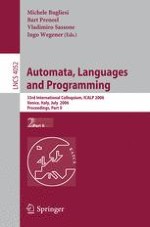2006 | Buch
Automata, Languages and Programming
33rd International Colloquium, ICALP 2006, Venice, Italy, July 10-14, 2006, Proceedings, Part II
herausgegeben von: Michele Bugliesi, Bart Preneel, Vladimiro Sassone, Ingo Wegener
Verlag: Springer Berlin Heidelberg
Buchreihe : Lecture Notes in Computer Science
